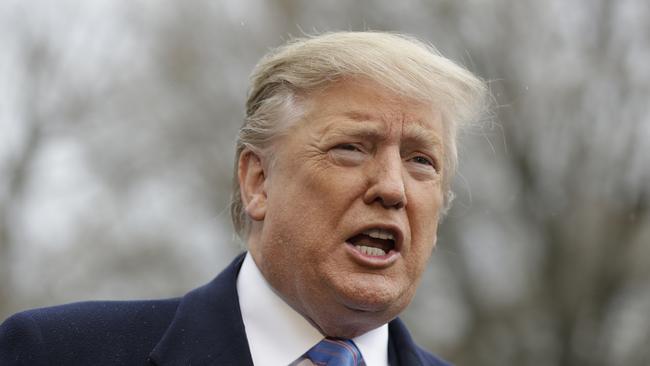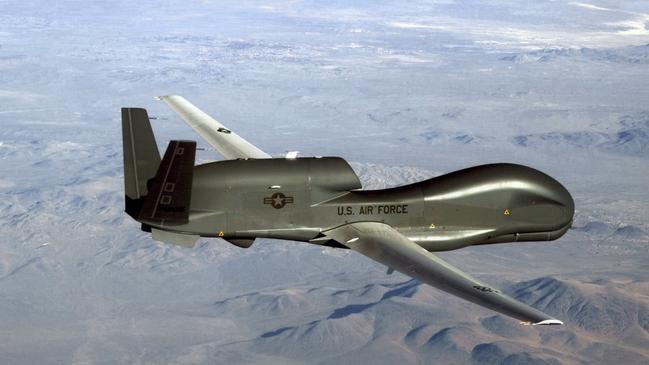US military approved plan to strike Iran, but abruptly withdrew
The US military made preparations to strike Iran, but the attack was abruptly called off.

The US was preparing to launch a retaliatory strike against Iran for shooting down an American reconnaissance drone on Thursday, but the mission was called off at the last minute, US officials said.
Details about the mission or the reason for the abrupt reversal of plans wasn’t immediately known, but officials said a future military response hasn’t been ruled out.
The US appeared to be edging closer to military confrontation throughout the day on Thursday as President Trump charged that Tehran had made “a very big mistake” in shooting down the unmanned drone.
But as the hours went by, each side refrained from additional escalatory steps, and Mr. Trump later appeared to defuse the crisis by suggesting that the shootdown might have been done without the blessing of Tehran’s top leadership.
“I imagine someone made a mistake,” Mr. Trump told reporters.
“We didn’t have a man or woman in the drone. It would have made a big, big difference.” The US has accused Iran of using mines to attack six foreign commercial ships, including oil tankers, and the two sides have been bitterly at odds over Iran’s nuclear program.
Seven weeks of acrimony
The developments on Thursday were a continuation of seven weeks of rising acrimony, with the US variously deploying ships, warplanes, troops and antimissile batteries, while accusing Iran forces of carrying out attacks on foreign ships and pro-Iran groups of rocket attacks around the region.
Iran made a very big mistake!
— Donald J. Trump (@realDonaldTrump) June 20, 2019
Leaders on each side have said they are not seeking war, and analysts have spelled out a range of scenarios on how each side might escalate the conflict as they undertake military preparations and manoeuvre diplomatically.
Nevertheless, the two sides aren’t involved in public or even unpublicised talks, officials say, and senior Pentagon officials have warned about the risk of miscalculation inherent in the protracted build-up.
The core issue has been the Trump administration’s insistence that Iran stop enriching all uranium and halt its “malign behaviour” in the Middle East or endure harsh sanctions that have pushed the Iranian economy into a deep recession.
Until Thursday, the Trump administration’s assumption had been that Iran would probably express its unhappiness with Washington’s stance by orchestrating mining attacks on foreign vessels and having allied militias strike US allies — while stopping short of attacking American forces.
‘Hands off. Don’t come after our forces’
General Paul Selva, the vice chairman of the Joint Chiefs of Staff, told reporters earlier this week that the US had sent messages to the Iranian regime warning: “Hands off. Don’t come after our forces.”
Iran’s shootdown of the unmanned drone led some analysts to speculate that Tehran had calculated that the attack would avoid triggering a US military response because it didn’t lead to American casualties.
Retired Adm. James Stavridis, a former North Atlantic Treaty Organization commander, described the attack as a “logical” but dangerous step for an Iranian regime that is trying to respond to the Trump administration’s campaign of maximum economic pressure with calibrated military actions of its own.
“Short of attacking a US Navy warship or shooting down a manned aircraft, this destruction of a $130 million US drone operating in international airspace is near the top of provocative moves imaginable,” Mr. Stavridis said in an interview.
Defending its actions, Iran insisted that the US RQ-4A Global Hawk surveillance drone was shot down in Iranian airspace, an assertion the U.S. Central Command flatly denied.
“We don’t seek war, but will zealously defend our skies, land & waters,” Foreign Minister Javad Zarif said on Twitter.
“We’ll take this new aggression to #UN & show that the US is lying about international waters.”

Iranian Deputy Foreign Minister Abbas Araghchi summoned the Swiss ambassador to a meeting at the Iranian foreign ministry Friday, to protest the American drone flight, the Iranian news agency Fars said. Switzerland represents US interests in Tehran.
The RQ-4A Global Hawk undertakes real-time intelligence, surveillance and reconnaissance missions over vast ocean and coastal regions, said Capt. Bill Urban, a spokesman for US forces in the Middle East. Manufactured by US-based Northrop Grumman Corp, it can fly for over 30 hours at a time and has the same wingspan as a Boeing 737 jet.
Punishing sanctions
Financially battered by punishing sanctions, Iran may have a number of reasons to ratchet up military tensions, analysts say. With its alleged mine attacks against foreign tankers, Iran demonstrated that it has the ability to hurt the world economy if the Trump administration persists with a campaign of punishing economic sanctions.
Raising the stakes in the region also might be an attempt by Iran to gain leverage if negotiations are ever held, since it could offer an end of hostilities as a concession.
Tehran wants to “make sure if talks begin at some point, Iran comes to the table with a full hand and bargaining chips,” said Ariane Tabatabai, an associate political scientist at the Rand Corp.
Iran’s economy has been in a tailspin since the Trump administration imposed what Secretary of State Mike Pompeo vowed would be “the strongest sanctions in history” and reimposed sanctions across broad bands of the country’s economy.
The Trump administration has insisted the sanctions will remain in place, and perhaps even tighten further, until Iran accedes to a far-reaching accord that requires it to remove its forces from Syria, cease its support for militant groups and end the enrichment of uranium.
Iran has sought to preserve a 2015 international nuclear accord, which allows low-level enrichment in return for Iran accepting constraints on its nuclear program.
That agreement was struck by Iran with Britain, France, Germany, China, Russia and the US, which withdrew last year.
Frustrated by the lack of sanctions relief, Iran recently has threatened to exceed the cap on low enriched uranium set by the agreement on June 27 if Tehran doesn’t begin to reap some of the economic benefits of sanctions relief it anticipated.
Trump administration officials have held out the hope that the economic measures might encourage the Iranian people to get rid of their leaders if the Iranian regime refuses to return to the negotiating table on US terms.
Analysts say, however, that Iranians are unlikely to rise up against the leadership in significant numbers and that, under pressure, various political factions in Iran have traditionally closed ranks.
“I think there is a sense across the political spectrum that Iran can’t just be victim and needs to find a way to push back,” said Afshon Ostovar, an assistant professor at the Naval PostgraduateSchool in Monterey, California, who has written a book about Iran’s Islamic Revolutionary Guard Corps.
Iran may lose sympathy
If Iran continues to escalate militarily, he said, it could jeopardise much of the sympathy it has received internationally by nations that are critical of Washington’s unilateral withdrawal from the nuclear deal
“Until now, Iran has been seen as the victim,” Mr Ostovar said. “If Iran continues with the same message, it will have diminishing returns.”
In Congress, concern has grown that the US may be drifting toward another Middle East war.
“If I don’t know the strategy, and you don’t know the strategy, then how do the Iranians know the strategy?” said Rep. Elissa Slotkin, a Michigan Democrat who previously served as a Central Intelligence Agency analyst and Pentagon official.
Watch: Iran releases footage it claims is of a missile strike on a US drone. @realDonaldTrump says the country "made a big mistake" shooting down the unnamed surveillance aircraft.
— Sky News (@SkyNews) June 20, 2019
Read the full story here: https://t.co/mx7Vtsy3Em pic.twitter.com/Sd2KeXH045
“And that is a recipe for misunderstanding, miscalculation and a spiral of escalation that stumbles into war.” Senate Majority Leader Mitch McConnell (R., Ky.) said after participating in a meeting at the White House that the administration is “engaged in what I would call measured responses,” without providing details.
House Speaker Nancy Pelosi described the meeting at the White House as intense. “How we go forward from here has to be strategic and smart and in close alliance with our allies that have common interests within the region,” she said.
Duelling narratives
Iran, appealing for international support, sent the United Nations Security Council a letter on Thursday asserting that the drone was on a spy mission when it was shot down, opening the door for duelling narratives to be presented to the world body.
Both countries agree that an Iranian surface-to-air missile downed the US unmanned aerial vehicle. Images provided by the two governments appear to show a similar flight path for the Global Hawk.
But the US contends that the drone was in international airspace, and approximately 18 nautical miles from Iranian territory, when it was downed. Tehran says it was flying in Iranian airspace.
Under guidelines set by the International Civil Aviation Organisation, a UN agency better known as ICAO, state aircraft may not overfly the territory of another country without permission and shouldn’t endanger civilian aircraft.
The international border for aircraft matches the maritime border of 12 nautical miles, according to ICAO.
Air Force Lt. Gen. Joseph Guastella, a top US commander in the Middle East, said the Iranian missile was fired by an Islamic Revolutionary Guard Corps unit near Goruk, Iran. The Iranian attack, he added, potentially endangered civilians because the Iranian surface-to-air missile was “in the vicinity of established air corridors” between Dubai and Muscat.
Iranian Foreign Minister Javad Zarif said on Twitter that the U.S. had moved beyond “economic terrorism” to covert action. He provided coordinates at which he claimed Iranian forces had targeted the U.S. drone “near Kouh-e Mobarak,” and said Iran had retrieved portions of the system from Iranian territorial waters.
Gen. Guastella said the UAV “had not violated Iranian airspace at any time during its mission,” and described as “categorically false” Iranian claims that it was in their airspace.
with Sune Engel Rasmussen and Siobhan Hughes
Wall Street Journal



To join the conversation, please log in. Don't have an account? Register
Join the conversation, you are commenting as Logout